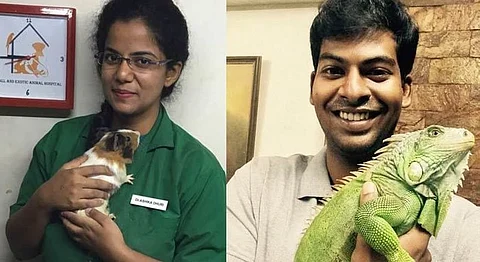
- HOMEGROWN WORLD
- #HGCREATORS
- #HGEXPLORE
- #HGVOICES
- #HGSHOP
- CAREERS
- ABOUT US
- CONTACT US

As we traipsed around Kandivali’s long streets dotted by tiny stores whose names we’d never heard of before, it began to dawn on us that expecting a stereotypical whitewashed building to scream, ‘Small And Exotic Animal Hospital’ was highly unlikely. A closer look at the stores, led the three of us to a little clinic, with a cat that resembled a loaf of white bread (she was incredibly chunky!) who greeted us from under a chair. The hospital that would have blended in seamlessly if it weren’t for the gigantic smiling dog poster on the outside, was set up back in 2015.
While it isn’t your average veterinary practice, their patients aren’t your stereotypical pets either. Run by Dr. Sharad Chavan and Dr. Ashika Dhuri, the duo are possibly the city’s only exotic animal vet clinic! “We’ve been working in this industry for years now, but noticed that there wasn’t anything specific for exotic animals like turtles, tortoises, snakes or guinea pigs. Our practice has about 80% exotic animals, and the rest are dogs and cats,” explains Dr. Ashika.
Of course, when it’s an exotic animal hospital, we had to know of the most exotic pet they’d come across as yet—a question the duo found amusing. “We’ve actually had quite a few Iguanas of late, it changes every season to be honest.” she laughs. While I remained slack-jawed (seriously, Mumbai. Iguanas is the trend you go with? Who could even cuddle up with that?!), Dr. Sharad takes up from where Dr. Ashika left off, “We’ve even had a snake in here once. But that was a rescue, who had cuts all over his body.”
As of now, their clientele includes several turtles and tortoises because it is nesting season. Unfortunately, the little critters aren’t in here to give birth to tinier critters, it’s because they can’t. “A common mistake that people make remains the same for exotic pets—they bring us their pets really late. Several reptiles we’ve looked at, haven’t seen a vet in three to four years! Lots of their owners simply don’t know how to take care of them, which is why during nesting season, we face the highest number of clients,” says Dr. Ashika, exasperated. The reptiles aren’t given calcium their whole lives, which leads to them becoming hypocalcemic, ultimately preventing them from being able to lay their own eggs.
While we were there, we got to see one of their current patients—Charlie, an extremely shy tortoise. Just as we were about to leave, in walked a trio, tugging along a nervous Cocker Spaniel. This of course, simply meant we had to stay—solely for further research. Walk-ins are usual for the clinic, as they see up to 20 animals on an average per day; their clients ranging from reptiles, to birds, fish, hamsters and guinea pigs.
As we walked out, little white-loaf-cat lay asleep under the chair, continuing her snooze fest. While their clinic may be quite a way off the typical path, rest assured, their work towards the exotic animal life is well appreciated by their customers, both new and old.
If you liked this article we suggest you read:
